STYLE AND SPLENDOUR
The Museum of Industrial Arts in Oslo holds a small, but fantastic collection of historical garments. In their collection is a blue/gold knitted jacket from the 17th century, a splendid green/gold mantua from the early 18th century, and the wardrobe of Queen Maud of Norway. Born in England in 1869, she became queen of Norway in 1905, and crowned in 1906. She bore one child, the future king Olav, and died in 1938. But first and foremost she was considered a true queen of fashion.
The latter was the subject of an exhibition held at Victoria & Albert Museum in England, from February 2, 2005 - January 8, 2006. The British interest in her was of course that Maud was the daughter of English Edward VII and Queen Alexandra, and granddaughter of queen Victoria. Maud's wardrobe, meticulously well preserved, shows both the finest craft of the early 20th century, and also how the style developed from corseted, S shaped silhouettes to straighter and more flowing dresses of the 1920s and 1930s. She was also well known for her narrow waist, between 16 and 18 inches (sources are inconsistent). Though fashion dictated little emphasis on the waist in the 1920s and 1930s, she would still maintain a preference for narrow dresses.
The V&A exhibition, called "Style and Splendour", also resulted in a book with the same title. Most of the pictures underneath is from this book. It's highly recommended, despite its non-chronological index and the tendency to linger more with the dress makers than the actual dresses. The book contains probably twice as many items than included here.
Various early photos of Queen Maud, plus the cover of the book
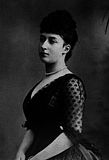

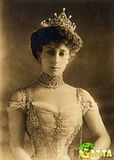
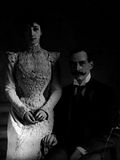
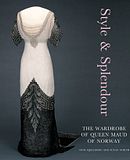
Me at the old exhibition of Queen Maud's dresses in Oslo.
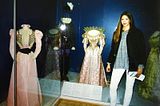
This picture was taken in the late 90s. The exhibition was different then. While Maud's wardrobe was on display in London in 2005, the museum renovated the top floor for a new and improved dress display. Last time I was there pictures was not allowed, but I think it is allowed again now. So stay tuned...
Going-away dress from 1896

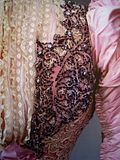
The going-away dress was the first dress the bride wore as a married woman. Maud's going-away dress is made of shot pink silk with a golden green nuance. The high necked bodice is decorated with cream lace and black and silver beads, and with a black belt in the waist. The sleeves are puffed at the top, and wrinkled all the way down. The skirt is gored, so it flares in the back, and the hem has cream lace trims. It was made by Madame Duboc in London, and included was a matching pink cape with the same decorations as the bodice front.
Fancy dress costume from 1897
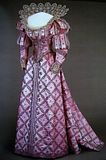
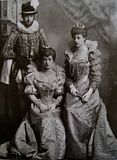
Pink is said to have been Queen Maud's favourite colour. No wonder then she choose that for her Renaissance styled fancy dress worn at the Devonshire House ball in July 1897. This fancy dress ball was in honour of Queen Victoria's Jubille in 1897, and it was considered the highlight of the year. The invitation stated that the guests had to wear an allegorical or historical costume dating before 1815. Maud's mother Alexandra choose an attire illuding Marguerite de Valois, queen of France. Her daughters were dressed as ladies-in-waiting for the lady Marguerite. Her fancy dress is hence meant to be a French 16th century dress.
The dress was made by Morin-Blossier in Paris. It's made of pink satin with a sheer silk and silver threads applied in an X pattern. The edge of the sheer silk has silver sequin and glass bead trims. Diamantes were then applied to the middle of these X'es. The corseted bodice have a top of pink satin strips with sheer silk poking out, and the same is repeated in the sleeves. The neck opening and cuffs have extravagant, though machine made, white lace. Much of the silver of the dress has oxidized, so it appears darker than it originally was. In the b/w picture above Maud's husband can be seen as a Danish courtier of the 16th century. He's even wearing a false beard for the occasion.
Coronation dress from 1902
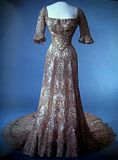
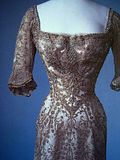
This dress was not worn for Maud's own coronation, but for that of her father Edward VII in August 1902. Judging from photos from the event and for later events, the dress has been remodeled once or twice. Especially the sleeves are different. The dress was made by Laferrière in Paris. They were one of the leading fashion houses in Paris at the turn of the century, and Maud had several gala and evening gowns made there. The dress has a cream satin silk fundament, overlaid with splendid machine made lace embroidered with gilt metal thread, sequins and diamantés. The waist is underlined by a defined V shape in the lace, fooling the eye to think it consists of a separate bodice and skirt. But it's made in one piece. The dress has a long train proper for the grand occasion.
Coronation dress from 1906
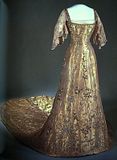


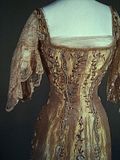
This dress was the one Queen Maud wore at her coronation in Norway in June 1906. It was a collaboration project between Vernon of London and Silkehuset in Oslo, though it's not clear exactly who did what. British press announced that it was sewn by Vernon and embroidered and decorated by Silkehuset. Norwegian press said it was sewn at Silkehuset from materials especially made in Lyons, and that the final alternations were done by Vernon. Whatever the case, it's a dress befitting a queen. It's made of silk gold lamé overlaid with flower and ribbon embroidery in gilt metal threads, gold sequins, pearls and diamanté. The dress also has scalloped lace sleeves. The bodice and skirt is made as one piece, and the skirt has a long train.
Coronation soirée dress from 1906
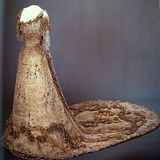
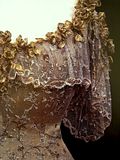
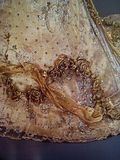
This was Maud's second coronation dress worn at a soirée held to celebrate the king and queen. It was made by Morin-Blossier in Paris, who had made her fancy dress some years earlier. the soirée dress was also used during a state visit to France the year after.
Like the one made for her father's coronation, it has a silk fundament with a lace overlay. The lace has embroideries and decorations of metal thread, sequins, pearls, diamantés and fabric flowers. The flowers are applied to the neck opening, the shoulders, down the back of the dress, and around the hem and the long train. The neck opening also has a fine, wide lace of pale beige tulle with decorations, and this functions as sleeves.
Admittedly, this is my favourite Maud dress ever.
Evening gowns from 1907-09
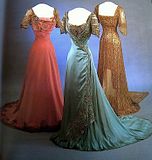
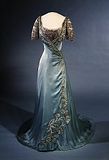
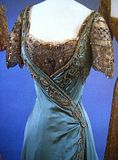
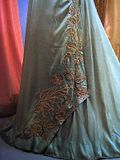
These three dresses shows that the princess silhouette, the lace sleeves and the long trains continued to be a part of the new queen's wardrobe after the coronation. The rose dress is made of pink silk with hem and bodice decorated with embroidered lace with diamanté, glass beads and metal threads. The bodice is lightly draped in front, and has large flower brooches on each side.
The ice-green dress is made of silk embroidered with silver. The book describes it as "...shaped like a pinafore over a blouse of metal lace, and the right front drapes asymmetrically over the left". The silver embroidery continues down the skirt front, on the overlapping side. The silver has oxidized slightly, so it looks more gold than silver. This is another of my favourites.
The golden dress is made of pale yellow silk with an overlay of tulle embroidered with a variety of golden threads, beads and sequins. The embroidery is applied so it alludes two layers; one being shorter than the other. The embroidery is also applied as long panels, narrowing in the waist and expanding at the hem, underlining the narrow waist. There is a drape in the back forming a train.
The "Arlesienne" from 1912-13

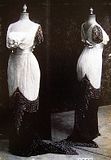
This Worth creation is the earliest known dress Worth made for Queen Maud. At least 9 more dresses and 1 suit were to come. But it's likely Maud ordered her clothes through the London branch of Worth. With the Greek architectural border and the acanthus leaf pattern, it shows the renewed interest in archeology of the era. It's made of white silk covered with tulle beaded in white/silver and black. The waist has become slightly higher than her previous dresses, and the skirt straighter. It still has a train, but constructed as a separate layer rather than a continuation of the skirt. A photo from the Worth collection at the V&A shows that this dress belonged to the 1912/13 winter collection. The photographed one has a satin band in the waist, ending in a rosetta in the back, as well as a satin flower in front. Maud's version has instead gotten a lighter drape and a diamanté "necklace" ending in an acanthus leaf.
Evening dress 1910-13
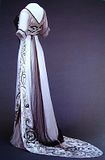
This evening dress shows an even higher waist, described as inspired by Paul Poiret's "Directoire" influenced style. The dress is made of white silk, embroidered with silk and glass beads in a swirling acanthus or menander like pattern hinting of the art nouveau style of the era. The skirt is narrow, and split at the side to reveal a tulle underskirt. There's also a black tulle drape in the back. The high bodice has elbow length sleeves.
Evening gowns, 1910-13
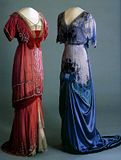
This picture has circulated on the web, and many seems to be confused of the origin of the dresses. They are from the "Style and splendour" book, originally worn by Queen Maud. A new love for layering, drapes and smart cuts can be seen in these dresses. The red dress is made of many materials of red, pink and silver shades. The fundament is pink silk an red silk chiffon, with a silver lace overlay. The red silk chiffon is draped to form a deep red contrast, and there's also red velvet drapes around the knee and in the front bodice. The dress is further embellished with silver embroidery and diamanté. A lace underskirt pokes out at the front hem.
The blue dress has a beaded "tunic" as basis, with royal blue satin in the back and caught up in front to form a drape, ending in a satin bow. The "tunic" has a beaded fringe overlapping the blue satin. Embroidered lace and chiffon is applied to the bodice, forming short sleeves. The hem is trimmed with fur.
Summer dress, 1915-17

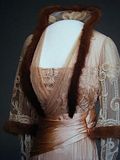
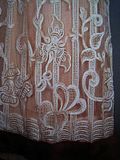
This dress is considered day wear for the summer, but a rather elaborate version of such. The fundament is nude silk, with an overlay of nude lace. The lace has decorations at the hem as well as at the sleeves and front bodice. Interestingly enough this summer dress has trims of fur. It seems to be purely fashionable and not climatical. There's also an assymetrical, broad silk belt. Along with the mock fold-over construction of the bodice front, the anonymous dress maker might have taken inspirations from Japanese kimonos.
Evening dresses from 1918-23
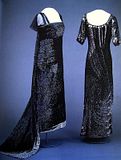
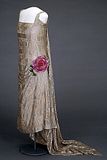
Sequined fabrics in dresses had been fashionable for decades, but the abstract swirling pattern was a newer element. These two black dresses shows an even more simplified form than the previous ones shown. These dresses don't have any boning or stiffening, and the waistline is less pronounced than before. The black dress on the left is made of sequins which runs in a variety of directions, and with diamanté and silver sequins at the hem, train and neck opening. There's also transparent black sleeves. The black dress to the right has stripes of silver blending with the black and ending in a swirling pattern around the knees. It has sequined, elbow-length sleeves, and stars in the neck opening.
The dress to the right is square and almost waistless in appearance, a bit shorter than before, and ending in a train in the back. It is slightly draped around the hips, and decorated with a large fuchsia flower with green leafs. There's also a long, vertical drape in the back. The nude silk fundament has a lace overlay. The lace has rows of stylistic birds, vases and hieroglyphs separated by broad bands. The wings of the birds overlaps these bands, and continues down to the row underneath. This corresponds with the Egyptology of the era, and the discovery of Tutaankhamun's tomb in 1922.
It is hard to believe these dresses were worn by a woman well past her 50s. But she kept her slender figure and appearance her whole life, and embraced the latest fashions in a classy way.
Evening gowns from 1929
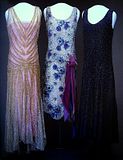
These three dresses were worn at the same occasion - the marriage of her son, crown prince Olav, to his Swedish cousin, princess Märtha, in 1929. The queen would turn 60 this year. For some reason I just find it so cool she remained so stylish as an adult. All three dresses has minimal waistline, asymmetrical hemlines, and with modern shoulder straps showing off a bit decolletage.
The pink dress to the left was made by Blancquaert in London and worn at a gala performance at the National Theatre in March 1929. Over a pink petticoat a beige and gold lace with radiating design is worn. The pattern forms a V at the torso, ending in a horizontal band around the hips. The rays are vertical in the skirt. The rays are further underlined by adding golden glass beads and metal beads.
The center dress was made by Reville-Terry in London, and was worn at a ball in the palace on March 1929. This ball formally began the wedding celebrations. The dress has a nude underlayer overlaid with transparent chiffon with pale grey velvet leaves and printed floral motifs in blue, pink, black and orange. The skirt hem is scalloped, and is decorated with beads and diamanté, as is the neck opening. A large purple velvet bow is attached at the left hip. it looks to me as if this is a top and a skirt rather than a dress - look at the scallops around the hip - but the book doesn't mention anything about that.
The dress on the right was most likely worn at a ball at the British Legation in March 1929. The dress is made of a shimmering beaded fabric of blue and black nuances, probably with a dark dress worn underneath. At the hem there are accenting coarse tulle, ending in a small train in the back.
Evening gowns 1930/1935

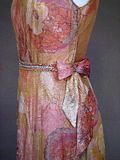

The evening gown from ca. 1930 is made of gold brocade with pink and violet flowers, accented with shades of grey, gold and beige. The bodice and skirt has bias cut insertions, and the dress depends largely on the elegant cut of the panels. There's also a "gem" belt and fabric bow in the waist, and a rosetta at the right shoulder.
The stripy evening dress from ca. 1935 depends largely on its draping and cut. The sheer stripy chiffon in grey, pink and blue shades is draped over itself, with the lower layer having the stripes set vertically, and the upper layer draped on the bias. This is further emphasized at the hem, where the skirt ending in V's with bias cut insertions. The dress also has a belt of the same fabric - or rather, it's the bias draped overlayer ending in a sash - and a rosetta at the left shoulder.
Evening dresses 1937-38
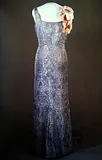
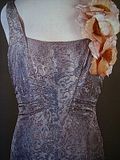

The silver and blue brocaded evening dress was made by Blancquaert in London. The silhouette is typical for the 1930s, but the queen was also fond of showing off her slender silhouette. The bodice and skirt is in one piece, but the bodice part is emphasized by the V panel in the front, with the other fabric draped slightly around it. The skirt gores slightly, and has a train. The dress has semi narrow shoulder straps, and with large pink flowers on the left side.
The black dress is of a similar silhouette, but here the bodice seems to be constructed individually, and with the skirt attached. There is a belt in the waist. The dress was made of black silk jersey, and with flower motics cut out from another fabric and applied to the right shoulder strap, the right side hem and the left side in the waist. The design is a lightly remodeled version of Worth's "Seduction" from 1938. The design shows a dress with more draped shoulder straps, and a bit wider skirt. Maud went for an even more slender silhouette.
The "Trotteur 1938-39
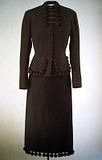

Stylish until the last. The suit "Trotteur" came from the 1938-39 winter collection of Worth. The design shows a knee length skirt and a tailored jacket, both items decorated with pompons. The jackets has additional "frog" fastening at the neck, and pockets with pompons. The sleeves are long. The shoulder's on Maud's jacket aren't as broad as the design, and she probably never ordered the muff, but otherwise the finished ensemble stays faithful to the designer's envision. Maud died in November 1938, and this was probably the last outfit Worth made for her.
All of these dresses are in the care of the Norwegian Museum of Industrial Arts (recently renamed National Museum of Design, but the new name never quite caught on...). Three of the dresses can be seen in their website, but the site leaves a lot to be desired... to say the least. However, the museum itself is well worth a visit.
Museum of Industrial Arts
St. Olavs gate, Oslo
http://harriet.nasjonalmuseet.no/draktgallerier/dronning-maud/
The V&A Museum has also kept their Maud site:
http://www.vam.ac.uk/vastatic/microsites/1333_styleandsplendour/index.html